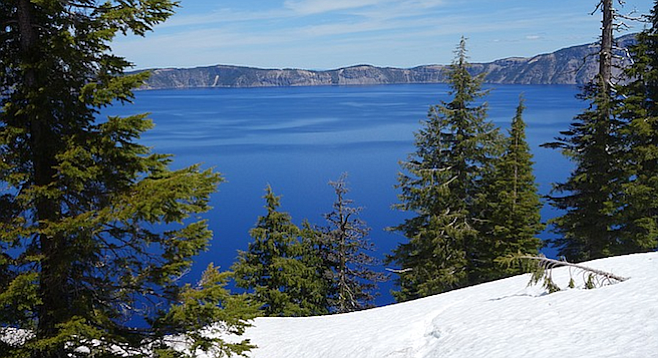Cold-Spring Waters
Water samples of cold springs were collected in the Crater Lake area from 1981 through 1985 at the locations shown in figure 1. An effort was made to sample all large discharging springs searching for evidence of Crater Lake water. Major-ion concentrations and water isotopes for cold-spring waters are reported in table la.
The cold spring waters discharging on the flanks on Mount Mazama have low total dissolved solids and are essentially a sodium-calcium-magnesium bicarbonate water (table la). Generally, the waters are neutral to slightly alkaline. The waters contain much less than 10 mg/L of dissolved sulfate and chloride and less than 1 mg/L of dissolved boron and lithium. Fluoride is just above the detection limit (0.1 mg/L). Dissolved silica in the waters is higher than would be expected for quartz solubility control. Quartz is not a common mineral in this area. Aluminosilicates and glassy volcanic rocks may be the source of the SiO2 in the cold-spring waters (C. R. Bacon, oral communication, 1987).
In general, spring waters discharging above the surface elevation of Crater Lake are remarkably similar to those discharging below it. Few chemical differences exist between intracaldera spring water and extracaldera spring water. However, in the vicinity of Chaski Slide, a large piece of hydrothermally altered volcanic rock that failed sometime after the climactic eruption, water passing over the slide material is relatively enriched in calcium and sulfate (Samples JCL 81-14 and 81-15 on figure 1). Not all waters discharging from the caldera walls were analyzed for deuterium and oxygen-18, because samples were not collected at the spring orifice and the effects of evaporation were unknown.
Springs above the lake all have chloride concentrations less than 0.4 mg/L whereas the lake has a chloride concentration of 10 mg/L (figure 2). The chloride concentration in the cold springs is similar to that measured in precipitation in western Oregon (Junge and Werbe, 1958), so that the chloride in the cold springs appears to be that which was in the water as precipitation. Because the lake loses 28 percent of its inflow by evaporation, the chloride concentration of the cold-spring water and direct precipitation into the lake can be raised by evaporation by no more than 40 percent. Thus the chloride concentration in the lake is quite anomalous compared to the available water supply.
Both Crater Lake-and Diamond Lake show the effect of evaporation on their isotopic contents, and they have distinctly different values from cold-spring samples both above and below the surface elevation of Crater Lake (figure 3). The evaporation trend is the empirical slope of five reported by Craig (1961). It is possible to use values for the isotopes to calculate this evaporation trend (e.g. Gonfiantini, 1986); however, there are a number of free parameters that have not been measured that are required to perform such a calculation. Mixing between Crater Lake water and other waters would be along a straight line in this diagram. Based on the isotopes, there is no single cold spring with a significant fraction of Crater Lake water.


